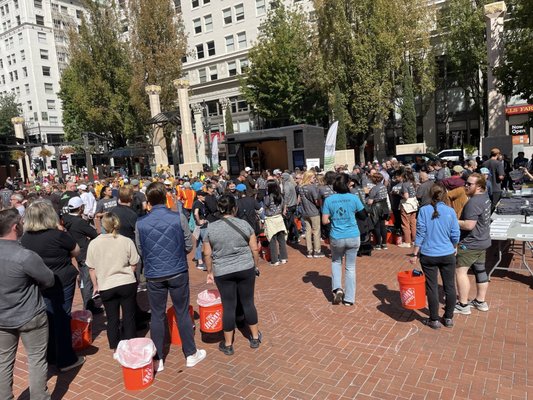Pioneer Courthouse Square
Public plaza hosts events, food carts, people-watching, and concerts
Public plaza hosts events, food carts, people-watching, and concerts

.jpg)























"I note that Starbucks Workers United will hold a protest at 1 p.m. today at Pioneer Courthouse Square to mobilize workers as it continues bargaining for a contract and to “demand the right to organize free from intimidation...and union busting tactics”; community allies are welcome, and SWU cites Oregon as having the highest density of organized stores in the nation, with 29 unionized stores." - Janey Wong

"Pickets were scheduled at Pioneer Courthouse Square on June 30 as part of the Strike With Pride actions in the Portland area, which joined a nationwide wave of strikes pressing Starbucks to negotiate a fair contract and respond to reports that managers have blocked Pride decorations and used tactics the union describes as union-busting against LGBTQ workers." - Janey Wong

"Portland's Quirkiest Tour! We all love a free tour and this introduction to Portland was a perfect one. What’s the tour, you ask? Well, it’s the Secrets of Portlandia tour of course! The walk covers all of the weird facts, sites, and signs that make Portland the crazy fun city it is. Eric's personality really makes the walk downtown an enjoyable one. The tour ends at Vodoo Doughnuts and across the street is the Keep Portland Weird sign for those irresistibly awkward photo ops! Note: This tour doesn’t discuss the show at all. I’m actually really surprised nobody has jumped on the bandwagon and decided to do a tour spotting the highlights of the show. Eric, our tour guide, points this out in the beginning of the tour."


"Historically the home of the Grand Tasting, Pioneer Courthouse Square used to host the two-day event where numerous chefs served up bites while wineries and breweries poured tastes and a stage featured speakers and cooking demonstrations, but Feast Portland has moved that signature tasting offsite this year." - Alex Frane

"This brick-lined plaza's central location—right in the heart of downtown, on the light rail line—has prompted it to bill itself as "Portland’s Living Room;" but with the recent arrival of five permanent carts, it might as well be considered a dining room, too. You'll see everyone descending on the square, from office workers on a lunch break, to hungry shoppers and tourists. There's something to please everyone here, from Burger Stevens' cheeseburgers (definitely the juiciest in town), to the offerings at Melty & Meaty, a genius partnership between the charcuterie experts at Olympia Provisions and the cheesemongers at Tillamook Cheese; Fried Egg I’m in Love focuses on drippy fried-egg sandwiches smothered in creative condiments, and Whole Bowl, the sole vegetarian spot, draws patrons in with its addictive sauce." - Danielle Centoni
.jpg)